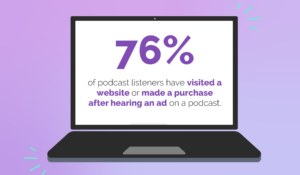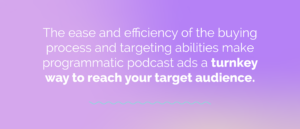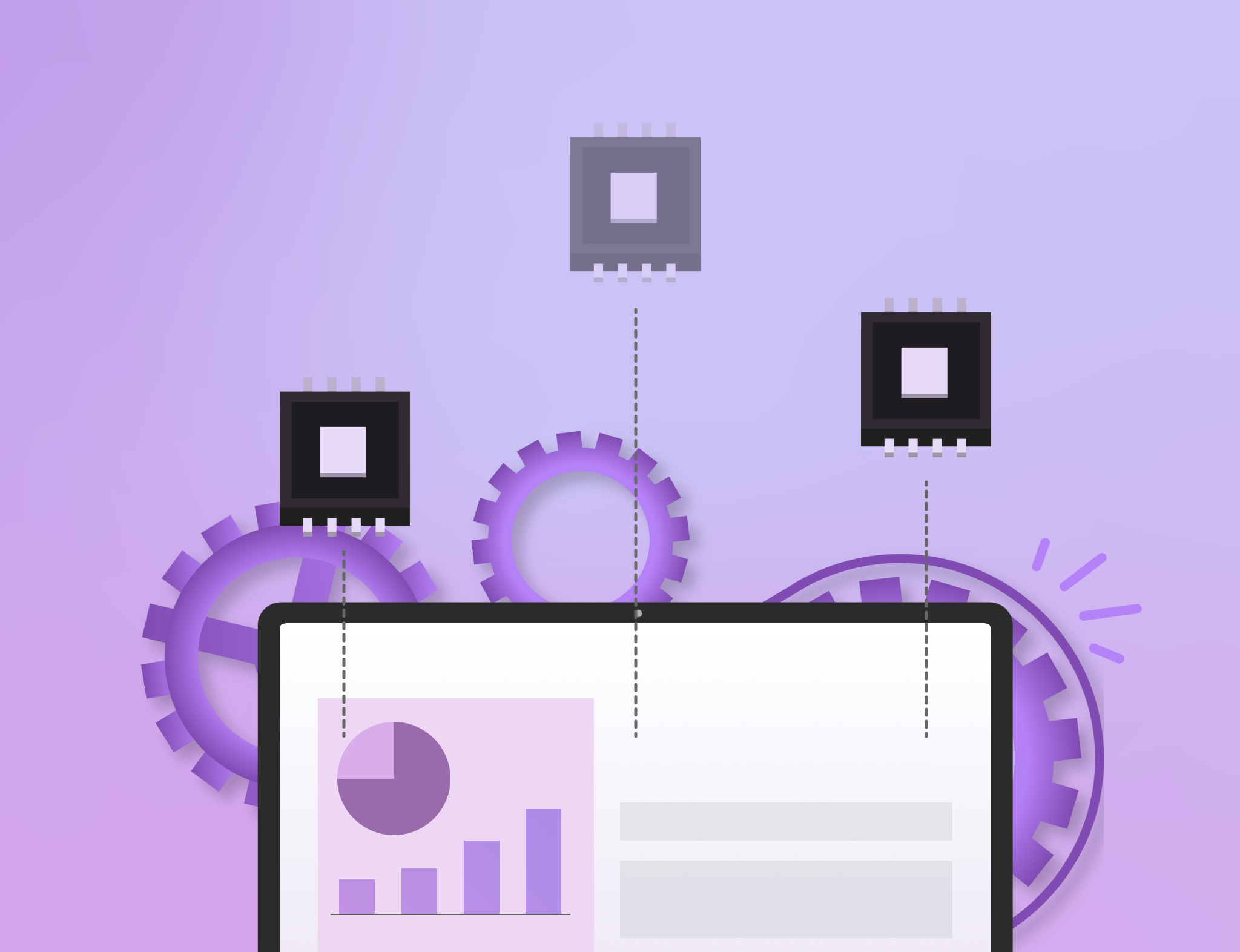In case you hadn’t noticed, podcasting is booming, with global listenership predicted to reach 505 billion people by the end of 2024.
The portable nature of podcasts means that people listen to them while cooking, commuting, or hitting the gym. It’s easy to see why these pieces of highly engaging audio content are becoming so popular — and why they represent a huge opportunity for advertisers.
With the number of podcast listeners still growing, the global podcast advertising market is expected to be worth $4 billion by the end of 2024, and 34% of audio advertising dollars in the US will go to podcast advertising this year.
If you’re thinking about integrating podcast ads into your 2024 strategy but are unsure where to start, read on — this article will cover the basics of podcast advertising to help you get started.
What is Podcast Advertising?
Podcast advertising refers to audio ads that are broadcast as part of a podcast episode. They include:
- Pre-roll: Ads that play before the podcast content begins
- Mid-roll: Ads that play in the middle of the episode
- Post-roll: Ads that play after the episode ends
- Host-read: Ads that the host reads aloud as part of the show
The length of a podcast ad varies, but in general, pre and post-roll ads are 15 seconds, while mid-roll ads can be up to 60 seconds, and host-read ads can last up to two minutes.
Podcast advertising is particularly powerful because it reaches audiences when they are highly engaged with the content, and the nature of audio creates a more intimate experience than other types of digital ads.
With programmatic advertising, advertisers can amplify the benefits of podcast advertising by targeting users with personalized ads.
Why Advertise on Podcasts?
Let’s start with three of the top reasons why brands and agencies are turning to podcast ads.
Reach New Audiences
Podcast ads allow you to tap into new audiences. Podcasts are searchable by topic, so by partnering with podcasts whose audiences reflect your target audience demographics, you can reach listeners who become potential customers.
Build Brand Awareness and Trust
Popular podcasts have an engaged audience — according to Buzzsprout, 80% of listeners listen to most or all of the podcast episodes they start. They trust their podcast hosts and are more likely to pay attention to their brand endorsements.
Podcast Listeners Like Podcast Ads
According to the Discover Pods Podcast Trends Report, 89.9% of podcast listeners believe podcast ads are effective, and 76% say they have visited a website or made a purchase after hearing an ad on a podcast.

Types of Podcast Ads and Positions
If you want to make the most of the potential of podcast ads, you’ll need to understand how they work — starting with the types of podcast ads available and where to position them.
Types of Podcast Ads
- Host-read ads: As the name suggests, these ads are read aloud by the host as part of the podcast. These are also known as live-read because they’re not pre-recorded.
- Pre-recorded ads: These ads are scripted and recorded ahead of time — either by the advertiser or the podcast host — and added to the podcast during post-production. They’re similar to a traditional radio spot.
- Baked-in ads: These are ads that form part of the podcast and therefore remain within the content for its lifetime. These types of ads are often host-read and leverage the personality and following of the podcast host.
- Dynamic ads: Dynamic ads are a type of programmatic advertising. The podcast recorder inserts ad slots into their episode, then partners with a podcast network that works to dynamically insert ads from thousands of advertisers based on audience targeting.
Positions
There are three main types of ad placement for podcast ads: pre-roll, mid-roll, and post-roll.
- Pre-roll ads: these are ads placed at the start of the podcast before the main content begins.
- Mid-roll ads: ads that appear in the middle of the content.
- Post-roll ads: ads that air after the end of the podcast content.
How to Get Started with Podcast Advertising
Ready to launch your first podcast advertising campaign? Follow these steps to get started.
In-House or Outsource?
The first thing to do is decide whether you’ll manage podcast advertising in-house or through a partner.
While keeping things in-house provides real-time access to results, with no waiting on data reports, working with a partner means you can leverage the agency’s experience and save time by eliminating the learning curve.
Understand Your Target Audience
As with any type of advertising, podcast ads are most effective when advertisers have a deep understanding of their target audience’s needs, habits, preferences, interests, geographic location, and more.
Knowing where and when your target audience listens to podcasts, the types of podcasts they listen to, and what they do while listening to them will help you find the best home for your podcast ads.
Identify the Best Podcast for Your Brand’s Advertising
The next step is to find the best podcasts to partner with. These should be podcasts with significant audiences that align with your target audience’s interests.
For example, if your business sells travel gear for digital nomads, then you’ll want to partner with popular podcasts aimed at digital nomads, Like Digital Nomad Stories, Digital Nomad Cafe, or Nomadtopia Radio.
Some important questions to ask yourself during this process include:
- Does my product or service align with the podcast audience?
- Does my ad campaign require targeting a macro audience or a niche audience with micro and nano influencers?
- Do they offer host-read ads as well as pre-recorded ones?
- How many regular listeners does the podcast have?
Understand the Cost Structure
Podcast ad prices are usually based on cost per mille, or CPM. This is the cost of the ad per every 1,000 impressions.
The price of your ad will vary depending on factors such as:
- The podcast host’s pricing structure
- The number of ad spots per episode
- The number of subscribers
- Ad length
- Whether your ads are pre-recorded or host-read.
Decide Where to Position Your Ad
The prime position for your ad spot is mid-roll, when audiences are most engaged and least likely to skip the ad — this is why mid-roll ads are generally more expensive than pre and post-roll.
Pre and post-roll ads are shorter and cost less. However, it’s easier for listeners to miss them since they aren’t part of the main podcast content.
Create a Podcast Ad Script
Once you’ve defined your target audience, identified some podcasts to host your ads, and decided where to place them, it’s time to create your ad script.
Keep in mind the length of your ad spot, the position of the ad insertion, and whether it’s pre-recorded or host-read. For host-read ads, you may only need to provide guidelines and let the host ad lib in their own style.
Pre-recorded ads require more precise planning and scripting. Make sure your copy is simple to read and easy to understand, use short sentences, and don’t forget a clear call to action.
Measure Ad Performance
Podcast ad performance is tracked through impressions in the form of podcast downloads. Additional metrics for measuring performance include:
- Social mentions
- Web hits
- Check-out surveys
How to Buy Podcast Ads
There are three main ways to buy podcast ads:
- Through a podcast network: This is an agency that helps connect podcasters and shows with brands and agencies to sell podcast ad spots. They usually have dedicated sales teams that match advertisers to podcast hosts based on criteria such as business objectives, target audience, and product relevance.
- Buying directly from individual podcasts: This requires the brand or agency to do their own research and outreach to find the best podcasts to advertise on. While it might save money on hiring a partner, you’ll lose time that you could be dedicating to other business activities.
- Programmatically through a demand-side platform (DSP): A DSP is a programmatic advertising platform that allows buyers to bid on ad space using automation. Since it can bid on ads in real-time, it makes the ad-buying process faster, more targeted, and more cost-efficient.
Programmatic Podcast Advertising: Why it Works
By now, you might be wondering which type of podcast ads would work best for your brand: baked-in host-read ads or dynamic programmatic ads.
The benefits of host-read ads are obvious — they’re more organic and leverage the persuasive power of the audience’s trust in their podcast host.
However, programmatic ads have other advantages over host-read ones. For example, the ease and efficiency of the buying process and targeting abilities make programmatic podcast ads a turnkey way to reach your target audience.

As platforms like Spotify continue to improve their programmatic ad services, dynamic podcast ads will continue to grow in both popularity and efficiency.
How Do You Measure the ROI of Podcast Advertising?
Measuring the ROI on podcast advertising requires a blend of direct tracking methods and analyzing broader marketing effects to measure both tangible and intangible outcomes, such as the following:
Unique promo codes: Provide a unique promo code that listeners can use when making a purchase or signing up for a service. This code directly links the transaction to the podcast ad, making it easier to track conversions and calculate the ad’s effectiveness.
Dedicated landing pages: Create unique landing pages on your website for listeners to visit and track them to see how much traffic, engagement, and conversions the ad generates.
Direct and indirect metrics: Direct metrics include conversions, sales, and leads directly attributable to the podcast ad. Indirect metrics might involve increases in website traffic, social media engagement, or search volume for your brand, indicating heightened awareness and interest.
UTM Parameters: Add UTM parameters to the URLs in your podcast ads. These parameters enable analytics platforms like Google Analytics to track the source, medium, and campaign, providing detailed insights into performance.
Brand awareness surveys: Provide surveys before and after the podcast advertising campaign to measure changes in brand awareness and perception that can help you see the indirect benefits of podcast advertising.
Reach New Audiences with Podcast Ads
Podcast advertising is a great way to connect with new audiences, raise brand awareness, and harness the popularity of audio content in your advertising efforts.
Still not sure if podcast advertising is right for your business? Check out the five benefits of audio advertising.






